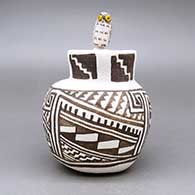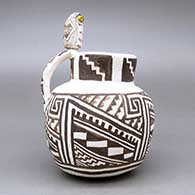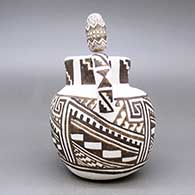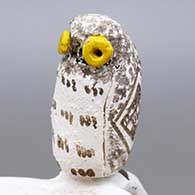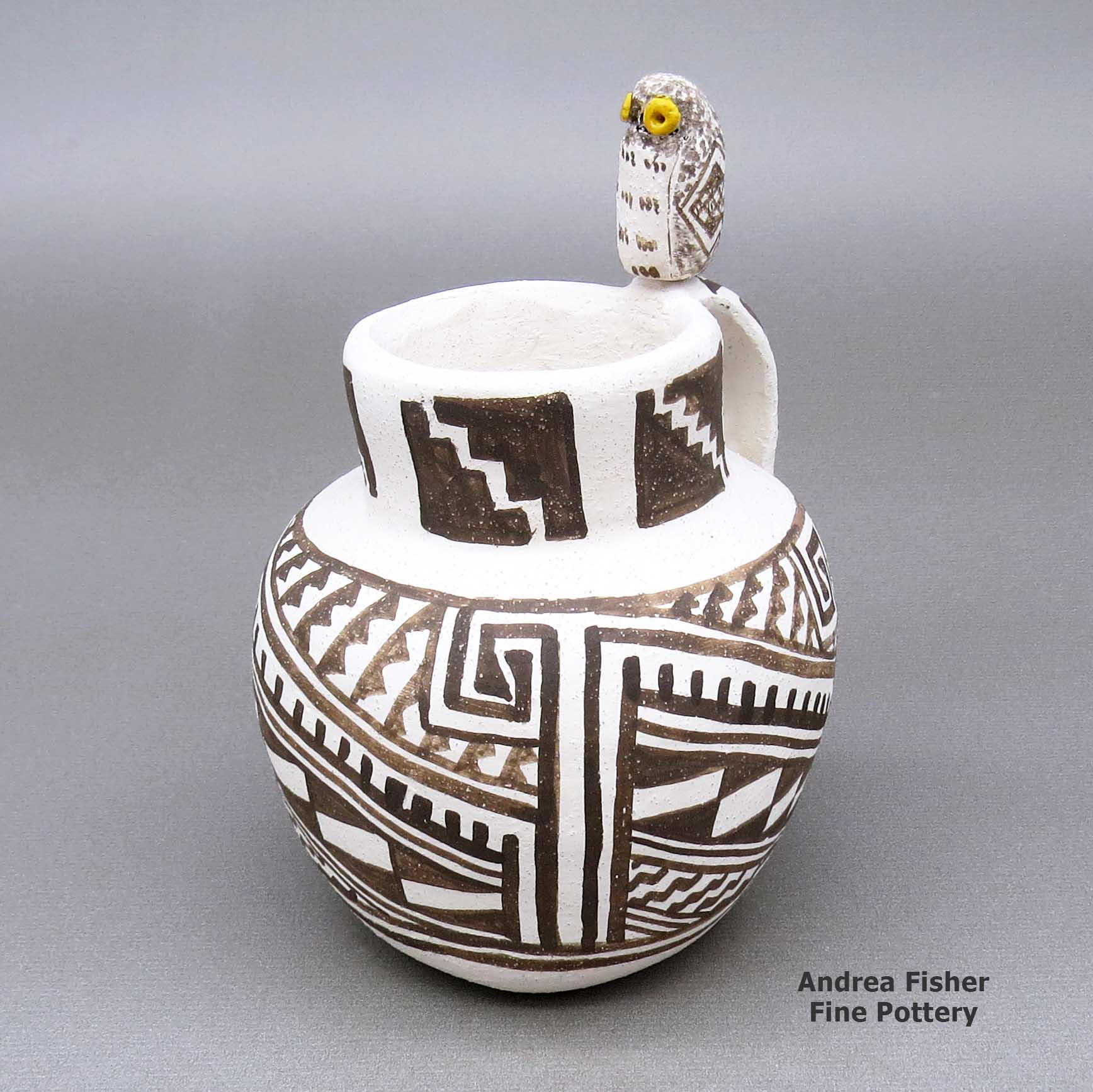
Isleta
$ 550
zzle4d052
Polychrome jar with a handle, a black-on-white painted kiva step and geometric design, and a miniature owl figure perched on the rim
3.25 in L by 3.25 in W by 5 in H
Condition: Excellent
Signature: Isleta W/T KD, with hallmarks
Date Created: 2024
Tell me more! Buy this piece!
(505) 986-1234 - www.andreafisherpottery.com - All Rights Reserved
Kimo DeCora
Isleta/Winnebago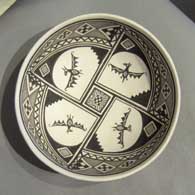
Born in 1951 to Rev. Wilbur J. DeCora and Lupita M. Jojola, Isleta Pueblo potter Kimo DeCora is half Isleta, half Winnebago. He learned the basics of traditional pottery making on his own but he also learned through watching Cipriano Romero Medina and John Montoya at work.
Kimo's favorite shapes to make are bowls, jars, small owls and his trademark miniatures. Over the years his pieces have earned him 18 blue ribbons at the Winnebago, NE Fine Arts Show, 6 more blue ribbons at the Albuquerque CeramicFest and several blue ribbons at Andrea Fisher Fine Pottery.
His inspiration comes from his pre-Columbian ancestors, and it's their designs he most often uses to decorate his work. His signature reflects his tribal affiliation (W/T: Winnebago Ho-Chunk / Isleta-Tiwa) and some subconscious doodling.
"I'm not the extrovert type and, like many others, don't need to be noticed to be happy ('Call me Hieronymous, cuz I like being anonymous'). It's a blessing to enjoy good health and be appreciated for the medium I express myself with. I also believe humor is a good thing."
Isleta Pueblo
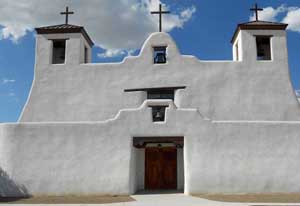
San Agustin de la Isletas Mission
Isleta Pueblo was founded in the 1300's. Archaeologists have put forth various ideas as to where the people came from with some scholars saying they migrated north from Mogollon/Mimbres settlements to the south while others say they migrated southwestward from either Chaco Canyon in the 1100's and 1200's or from the Four Corners area in the 1200's and 1300's. Their Tiwa language is shared with nearby Sandia Pueblo and a very similar tongue is spoken to the north at Taos and Picuris Pueblos. The two dialects are sometimes referred to as Southern and Northern Tiwa.
When the Spanish arrived in the area they named the pueblo "Isleta" (meaning: island). The residents were relatively accommodating to the Spanish priests when compared to the reception the same priests got in other areas of Nuevo Mexico (making Isleta something of an "island of safety" for the Spanish in an ocean of hostility). When the Pueblo Revolt of 1680 happened, Isleta either couldn't or wouldn't participate in the rebellion. When the Spanish governor left Santa Fe he went to Isleta and gathered his troops. None wanted to go back and fight so when they left and headed south, many Isletans went south to the El Paso area with them. Others fled to the Hopi settlements in Arizona and returned after the fighting was clearly over, many with Hopi spouses. When the Spanish returned in 1682 they found the Isleta mission church burned and the main structure was being used as a livestock pen. When the Spanish returned in force in 1692 they found Isleta empty and burned. The governor ordered the pueblo be rebuilt and resettled so residents were brought in from Taos and Picuris to the north and from Ysleta del Sur to the south, near El Paso. By 1720 a new, grander mission had been rebuilt on the foundations of the first.
Over the next century dissident members of the Laguna and Acoma Pueblo communities migrated to Isleta. While they were welcomed into the main Isleta pueblo at first, friction developed over the years until in the 1800's, the small communities of Oraibi and Chicale were established and most of the newcomers moved to one or the other.
The advent of the railroad in New Mexico was almost the end of the Isleta community as so many of the men went to work for the railroad. While the remaining residents managed to hold on to some of their social and religious practices, other elements of their culture almost disappeared, pottery making being one of those traditions that barely survived.
Today, making pottery the traditional way is practiced by only a few potters and their close family members.
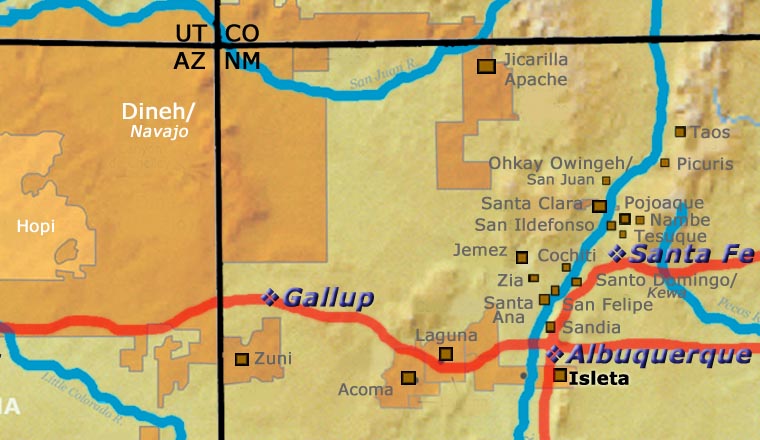
Miniatures
Most people think that miniature pottery is something new in the world of Native American pottery. In reality, archaeologists have found miniature pottery in the remains of ancient ruins in Chaco Canyon, Mesa Verde, across eastern Arizona, southern New Mexico and south to the Paquimé and Casas Grandes region in northern Mexico. Archaeologists working in the eastern US have found miniature pottery spread across Early Woodland Culture sites, too, dated up to 1700 years ago.
We have no idea as to why the ancients created miniature pottery but there's lots of speculation. Perhaps it was made as toys for children. Perhaps it was made by children learning to make pottery, and as their expertise grew, the size of their pieces grew, too. Perhaps it was made and placed in a firing pit as a good luck charm, hoping that other pots being fired in the pit would survive the firing process and not crack or break. Perhaps it was made for some ceremonial purpose we have no possibility of knowing. We do know that in North America, almost every pottery-making group of ancients made miniature pottery. They decorated it, too, just like the full size pottery the women of the time were making.
As the rebirth of traditionally made Native American pottery has unfolded over the last century, research into the ancient forms, styles and designs has also brought the miniature back into focus. There are more than a few potters these days making tiny gems again, similar to and, at the same time, more refined than the products of the potters of prehistory. And while some are still being made by children learning as they grow up, many more are being made by established adult potters. Some have made their entire careers around the making of miniatures while others sometimes make a few miniatures to complement the full range of forms and styles of full size pieces they make.
Copyright © 1998-2024 by


